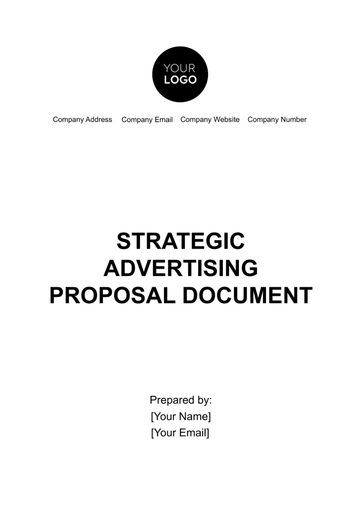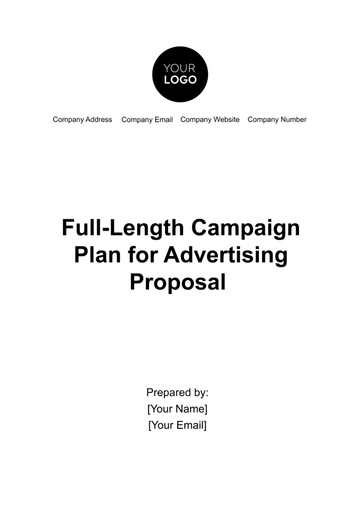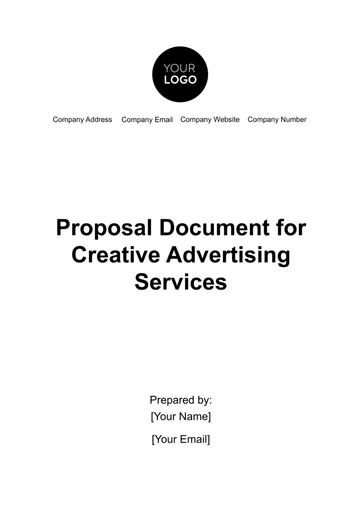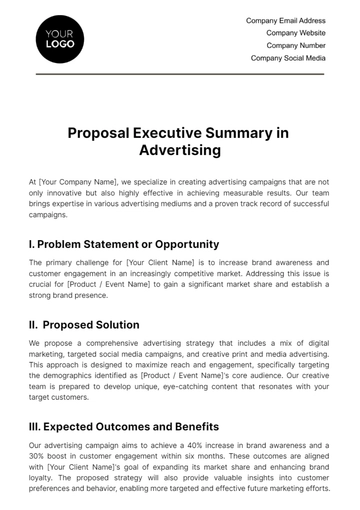Free Market Entry Strategy Advertising Proposal

Executive Summary
A. Introduction
In this proposal, [Your Company Name] is thrilled to present a comprehensive market entry strategy for "[Product Name]" our cutting-edge electric bicycle product, in the dynamic and eco-conscious market of San Francisco, California. Our goal is to outline a strategic approach that will not only allow us to penetrate this market effectively but also position [Product Name] as the premier choice for sustainable urban commuting.
B. Purpose of the Proposal
The primary purpose of this proposal is to provide a detailed roadmap for entering the San Francisco market with a focus on promoting "[Product Name]" We recognize that a well-executed market entry strategy is crucial for achieving sustainable growth and profitability in a new market. This proposal aims to serve as a guiding document for our collaborative efforts.
C. Key Objectives
Our key objectives for this market entry strategy include:
Market Penetration: To establish a strong foothold in the San Francisco market and gain a significant market share of at least 15% within the first 2 years of operation.
Brand Recognition: To create a brand presence that resonates with the local audience and establishes [Product Name] as a trusted and preferred choice for eco-friendly urban commuting.
Customer Engagement: To engage with the target audience effectively through various marketing channels, fostering lasting customer relationships.
Company Overview
A. [Your Company Name] Background
[Your Company Name] is a well-established player in the electric mobility industry with a history spanning two decades. Our journey began with a commitment to delivering innovative and sustainable transportation solutions. Over the years, we have earned a reputation for excellence and have become synonymous with quality and reliability.
B. Expertise and Capabilities
Our team at [Your Company Name] comprises seasoned professionals who excel in their respective fields. From electric vehicle engineers and marketing strategists to sustainable transportation experts and customer service specialists, we have assembled a dedicated team with diverse skills. We have successfully launched and marketed several electric vehicle models, including "EcoScoot" and "EcoCar," in various markets, showcasing our ability to adapt to changing consumer preferences and market dynamics.
Market Research
A. Market Analysis
Industry Trends and Insights
In the target market, the electric bicycle industry has experienced remarkable growth over the past five years. According to recent data, the adoption of electric bicycles has increased by 65% annually. This growth can be attributed to a rising awareness of environmental concerns, a shift towards sustainable transportation, and the desire for a healthier lifestyle among the local population.
Additionally, our research reveals that there is a growing demand for electric bicycles among commuters in San Francisco. With the city's focus on reducing carbon emissions and improving urban mobility, [Product Name] is well-positioned to address this need.
Target Audience Analysis
Our target audience comprises environmentally-conscious urban commuters aged 25 to 45, primarily residing within San Francisco. They are tech-savvy, value sustainability, and seek convenient and cost-effective transportation solutions. Understanding their preferences, pain points, and habits will be vital in tailoring our marketing efforts effectively.
B. Competitive Analysis
Main Competitors
Key competitors in the San Francisco electric bicycle market include [Competitor 1], [Competitor 2], and [Competitor 3]. These companies offer a range of electric bicycle models, each with its unique features and pricing. However, [Product Name] stands out due to its advanced battery technology, longer range, and sleek design.
SWOT Analysis
Strengths: [Product Name] offers superior battery life, a mobile app for enhanced user experience, and a strong commitment to sustainability.
Weaknesses: As a newcomer to the San Francisco market, we lack established brand recognition compared to some competitors.
Opportunities: The city's push for eco-friendly transportation and our unique features provide us with a significant opportunity for market growth.
Threats: Intense competition and potential regulatory changes could pose challenges.
Proposed Market Entry Strategy
A. Market Entry Methods
We propose the following market entry methods:
Exporting
Initially, we will export a limited quantity of units to gauge market interest. This approach allows us to minimize risk while testing the waters in San Francisco.
Licensing
Exploring licensing agreements with local retailers to carry [Product Name] in their stores. This strategy leverages the existing distribution networks and local knowledge of our partners.
Joint Ventures
Consider forming joint ventures with eco-conscious organizations or bicycle rental companies to introduce [Product Name] as part of their sustainable transportation offerings.
Strategic Alliances
Seek partnerships with local environmental organizations and government initiatives to promote [Product Name] as an eco-friendly transportation solution.
B. Market Entry Timeline
Month | Activity |
Month 1-2 | Market Research and Partner Identification |
Month 3-6 | Product Export and Testing |
Month 7-12 | Licensing and Joint Venture Negotiations |
Month 13-18 | Product Launch and Marketing Campaign |
C. Budget Allocation
An estimated budget of $2.7 million will be allocated for the market entry strategy. This includes product export costs, licensing fees, marketing expenses, and promotional campaigns.
Advertising Strategy
A. Advertising Channels
1. Online Advertising
We will allocate 30% of the advertising budget to online advertising channels. This will include targeted Google Ads campaigns, display advertising on popular local websites, and sponsored social media posts. With an estimated monthly budget of $50,000, this will reach an audience of approximately 300,000 unique viewers per month.
Social Media Advertising
Social media platforms like Facebook, Instagram, and Twitter are ideal for reaching our target audience. We'll allocate 25% of the budget to social media advertising. With a monthly budget of $40,000, this will result in an estimated reach of 250,000 impressions per month.
Print Advertising
While digital advertising is crucial, we'll also allocate 15% of the budget to print advertising in local magazines and newspapers. This will enhance our brand visibility among readers interested in eco-friendly transportation solutions. With a quarterly budget of $15,000, this will reach an estimated 50,000 readers per quarter.
Television and Radio Advertising
For broader exposure, we'll invest 20% of the budget in television and radio advertising. With a monthly budget of $60,000, this will result in an estimated 200,000 viewers and 150,000 listeners reached per month, respectively.
B. Creative Content and Design
Our creative team will craft compelling ad creatives for each channel, emphasizing the unique features of "[Product Name]" such as its advanced battery technology and sleek design, to engage and captivate our target audience effectively.
Implementation Plan
A. Team and Responsibilities
Marketing Team: Led by [Your Name], the marketing team will oversee the entire advertising campaign. Responsibilities include campaign strategy, content creation, and performance analysis.
Sales Team: Under the leadership of a Sales Manager, the sales team will handle customer inquiries, provide product demonstrations, and facilitate sales.
Technical Support Team: Headed by a Technical Support Manager, this team will provide post-purchase support, including technical assistance, maintenance, and troubleshooting.
B. Milestones and Timeline
Milestone | Start Date | End Date | Responsible Team | Budget Allocation |
Market Research and Analysis | [01/15/2050] | [03/15/2050] | Marketing Team | [$300,000] |
Product Export and Testing | [04/01/2050] | [06/30/2050] | Sales Team | [$500,000] |
Licensing and Joint Ventures | [07/15/2050] | [09/30/2050] | Sales Team | [$700,000] |
Product Launch and Marketing | [10/15/2050] | [12/31/2050] | Marketing Team | [$1,000,000] |
Technical Support Integration | [01/15/2051] | [03/15/2051] | Technical Support Team | [$200,000] |
Evaluation and Adjustment | [04/01/2051] | [06/30/2051] | Entire Team | [$100,000] |
C. Resource Allocation
Financial Resources: An estimated budget of $2.7 million has been allocated for the entire implementation plan, covering market research, product export, licensing, marketing campaigns, technical support, and evaluation.
Human Resources: A dedicated team of 10 marketing professionals, 15 sales representatives, 5 technical support specialists, and 3 project managers will execute the plan.
Technology and Tools: We will utilize state-of-the-art marketing analytics tools, customer relationship management (CRM) software, and customer support platforms to ensure seamless execution and monitoring of the plan.
Physical Resources: We will establish a local office in San Francisco by [01/15/2050] to oversee operations and provide customer support, ensuring a physical presence in the target market.
Measurement and Evaluation
A. Key Performance Indicators (KPIs)
To gauge the success of our market entry strategy, we will track the following key performance indicators (KPIs):
Market Share: We aim to achieve a market share of at least 15% within the first 2 years. We will monitor market share quarterly.
Brand Awareness: We will measure brand awareness by conducting surveys and tracking social media mentions. Our goal is to achieve a 30% increase in brand recognition within the first year.
Sales Growth: We aim for steady sales growth over time. We will track monthly and annual sales figures to ensure we are on target to meet our objectives.
Customer Engagement: We will monitor customer engagement through website traffic, social media interactions, and customer feedback. Our goal is to maintain a consistent increase in engagement metrics.
Return on Investment (ROI): We will assess the ROI of our advertising campaigns by comparing the cost of advertising to the revenue generated from [Product Name] sales. Our target ROI is a minimum of 3:1.
B. Data Tracking and Analytics
We will employ advanced data tracking and analytics tools to collect and analyze relevant data. This includes website analytics, social media engagement metrics, sales data, and customer feedback. Regular reports will be generated to provide insights into our progress.
C. Regular Reporting
We will provide monthly reports summarizing the performance of our market entry strategy. These reports will include KPI updates, insights from data analysis, and any necessary adjustments to the strategy. Quarterly reviews with stakeholders will ensure transparency and alignment with our objectives.
Risk Assessment and Mitigation
A. Potential Risks
As we embark on this market entry strategy, it's crucial to identify potential risks:
Competitive Pressure: Intense competition from existing players in the San Francisco market may impact our market share and profitability.
Regulatory Changes: Changes in local regulations related to electric bicycles or environmental standards could affect our operations.
Economic Factors: Economic downturns or fluctuations in consumer spending could impact sales.
B. Risk Mitigation Strategies
To address these risks, we have developed the following mitigation strategies:
Competitive Analysis: Continuously monitor competitors' strategies and adapt our approach accordingly to stay competitive.
Regulatory Compliance: Stay informed about local regulations and proactively ensure compliance.
Diversified Marketing: Maintain a diversified marketing strategy to mitigate the impact of economic fluctuations.
Contingency Plans: Develop contingency plans for potential challenges to respond swiftly and effectively.
Conclusion
A. Summary of the Proposal
This Market Entry Strategy Advertising Proposal outlines a comprehensive plan to introduce "[Product Name]" our innovative electric bicycle product, to the dynamic and eco-conscious market of San Francisco. We have meticulously analyzed the market, identified key objectives, and crafted a strategic approach to ensure our success in this endeavor.
Throughout this proposal, we have highlighted:
Market Potential: San Francisco's growing demand for eco-friendly transportation solutions presents a significant opportunity for "[Product Name]"
Strategic Approach: Our market entry strategy combines exporting, licensing, joint ventures, and strategic alliances to penetrate the market effectively.
Advertising Strategy: We have allocated budget and resources to various advertising channels, including online, social media, print, television, and radio, to maximize our reach and impact.
Implementation Plan: A dedicated and experienced team will execute the plan, ensuring a seamless market entry process.
Measurement and Evaluation: Key performance indicators will be tracked, and regular reporting will keep stakeholders informed of our progress.
Risk Mitigation: We have identified potential risks and developed strategies to mitigate them.
B. Call to Action
We invite you to join us on this exciting journey. Collaborating with [Your Company Name] to bring [Product Name] to San Francisco not only aligns with our commitment to sustainable transportation but also offers an incredible business opportunity. Together, we can make a substantial impact on the eco-conscious commuting landscape of San Francisco.
Thank you for considering our proposal. We look forward to the prospect of a successful partnership and the positive change we can bring to the city of San Francisco with "[Product Name]"
- 100% Customizable, free editor
- Access 1 Million+ Templates, photo’s & graphics
- Download or share as a template
- Click and replace photos, graphics, text, backgrounds
- Resize, crop, AI write & more
- Access advanced editor
Elevate your market entry game with Template.net's Market Entry Strategy Advertising Proposal Template. Effortlessly customizable and fully editable using our AI Editor Tool, this template streamlines the process of crafting compelling proposals. Seamlessly navigate market dynamics and capture opportunities with Template.net's user-friendly solutions.
You may also like
- Business Proposal
- Research Proposal
- Proposal Request
- Project Proposal
- Grant Proposal
- Photography Proposal
- Job Proposal
- Budget Proposal
- Marketing Proposal
- Branding Proposal
- Advertising Proposal
- Sales Proposal
- Startup Proposal
- Event Proposal
- Creative Proposal
- Restaurant Proposal
- Blank Proposal
- One Page Proposal
- Proposal Report
- IT Proposal
- Non Profit Proposal
- Training Proposal
- Construction Proposal
- School Proposal
- Cleaning Proposal
- Contract Proposal
- HR Proposal
- Travel Agency Proposal
- Small Business Proposal
- Investment Proposal
- Bid Proposal
- Retail Business Proposal
- Sponsorship Proposal
- Academic Proposal
- Partnership Proposal
- Work Proposal
- Agency Proposal
- University Proposal
- Accounting Proposal
- Real Estate Proposal
- Hotel Proposal
- Product Proposal
- Advertising Agency Proposal
- Development Proposal
- Loan Proposal
- Website Proposal
- Nursing Home Proposal
- Financial Proposal
- Salon Proposal
- Freelancer Proposal
- Funding Proposal
- Work from Home Proposal
- Company Proposal
- Consulting Proposal
- Educational Proposal
- Construction Bid Proposal
- Interior Design Proposal
- New Product Proposal
- Sports Proposal
- Corporate Proposal
- Food Proposal
- Property Proposal
- Maintenance Proposal
- Purchase Proposal
- Rental Proposal
- Recruitment Proposal
- Social Media Proposal
- Travel Proposal
- Trip Proposal
- Software Proposal
- Conference Proposal
- Graphic Design Proposal
- Law Firm Proposal
- Medical Proposal
- Music Proposal
- Pricing Proposal
- SEO Proposal
- Strategy Proposal
- Technical Proposal
- Coaching Proposal
- Ecommerce Proposal
- Fundraising Proposal
- Landscaping Proposal
- Charity Proposal
- Contractor Proposal
- Exhibition Proposal
- Art Proposal
- Mobile Proposal
- Equipment Proposal
- Student Proposal
- Engineering Proposal
- Business Proposal





























